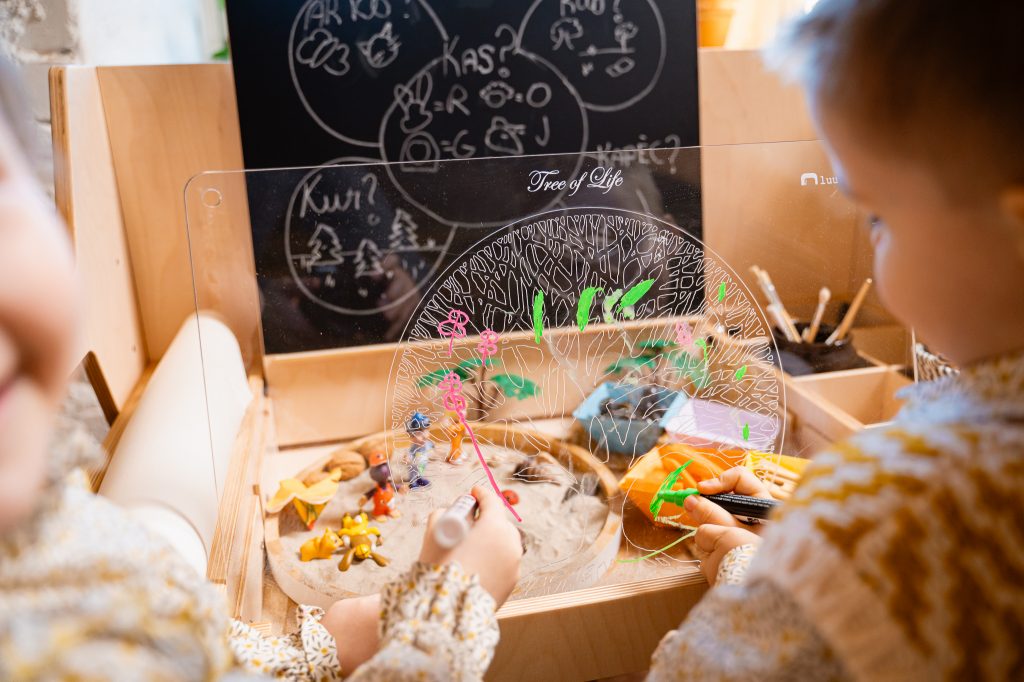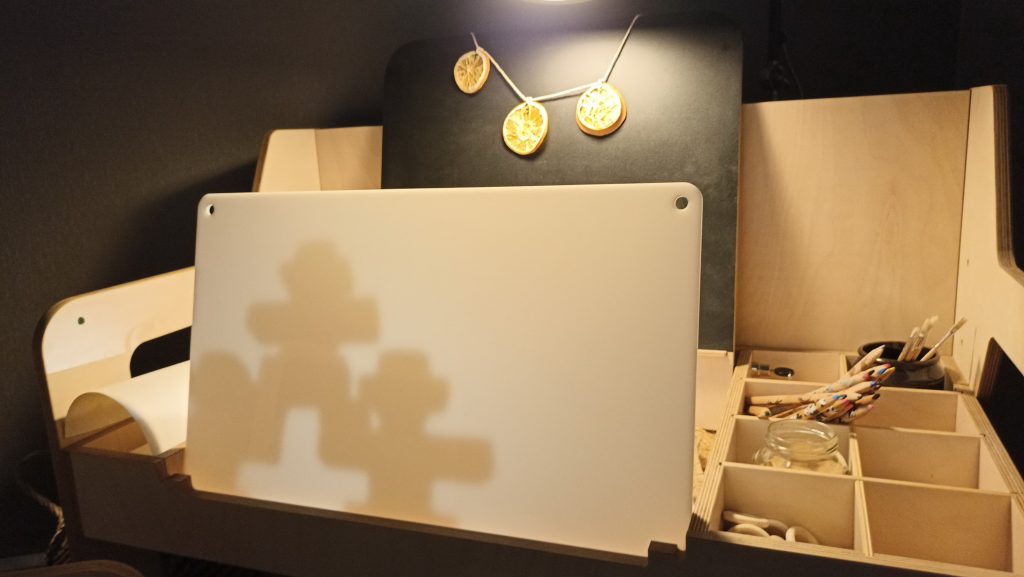The Luula adjustable table is an excellent tool to spark an interest in learning through play during preschool years and beyond. It creates a dynamic, interactive, and multisensory learning environment, perfect for preparing children for their first school experiences. Its adaptability allows students to combine hands-on activities with theoretical knowledge, making the learning process more engaging, efficient, and diverse.
A unique feature of the Luula table is its transparent acrylic board, which can be positioned horizontally or vertically in three different ways—front, middle, or above the blackboard. This design allows children to:
✔ Build 3D spaces and enhance them with drawings on the board.
✔ Develop proper hand grip and fine motor skills by writing on a vertical surface.
✔ Create interactive and spatial learning situations that foster imagination and spatial thinking.
Below, you’ll find specific ideas for how to use these features in fun and educational activities!
1. Developing Writing and Reading Skills
✅ Writing on a Vertical Surface – Building Proper Hand Grip
- Writing on the vertical board helps children develop the correct grip for holding a pen and strengthens their hand muscles.
- Activity: “Big Letters!” – Children write large letters and syllables on the vertical board using broad arm movements. This improves their handwriting and coordination.

✅ Interactive Word and Story Creation
- Children can draw or write on the acrylic board while it’s in a horizontal position inside the table. They can add visual elements to stories displayed in the sandbox beneath the board.
- Activity: “Draw and Write!” – Children draw on the horizontal acrylic board and then write their story on the vertical black chalkboard, practicing both reading and writing.
✅ Creating 3D Words and Sentences
- The horizontally positioned board serves as a platform for creating 3D stories.
- Activity: “Word Stories!” – Children write random action words on the transparent board positioned over toys in the sandbox. Using chalk on the blackboard, they write sentences that incorporate the toys and the action words, forming visual connections between the tasks. Extend this activity by encouraging children to turn their sentences into imaginative stories.
2. Math and Logical Thinking
✅ Understanding Shapes and Spatial Relationships
- Children can draw environmental objects and shapes on the horizontal board, creating maps of the areas where actions take place.
- Activity: Children draw scenes on the vertical board that depict a view from a pedestrian’s perspective—streets, buildings, or landscapes. Then, they enhance the space with real objects.
✅ Playing Math Games in a 3D Space
- Use the sandbox to create interactive math exercises or story environments.
- Activity: “Number Path!” – Children write math problems (e.g., addition or subtraction) on the horizontal transparent board using markers. They solve these problems by matching numbers to operations, helping them visualize math concepts.
✅ Understanding Money and Measurements
- Children use the sandbox as a pretend store with cards, toys, or snacks.
- Activity: “Market Counter!” – They write item quantities and prices on the horizontal acrylic board and perform calculations on the vertical blackboard to determine totals and change.
3. Science Experiments and STEM Activities
✅ Physics and Natural Science Experiments
- Use the sandbox to create water, sand, or material-based landscapes representing different climatic zones. Add natural items like kinetic sand, moss, pebbles, shells, or seeds to enhance exploration.
- Activity: “Rivers and Mountains!” – Children draw the animals or settlements found in these regions on the horizontal acrylic board and plan ideal routes for resources or trade.

✅ Light and Shadow Experiments
- The acrylic board is perfect for exploring light permeability and creating shadows.
- Activity: “Color Mixing!” – Layer colored transparent sheets on the acrylic board and overlap them in different ways to observe how colors blend. Add light sources to create shadow effects, or make paper figures for shadow theater.
4. Creative Arts and Drama
✅ Enhancing Drawings with 3D Elements
- Children place finished drawings on the edge of the blackboard and create scenes in the sandbox. Then add elements using toys, paper, or natural materials in the sandbox.
- Activity: Use the horizontal acrylic board to draw additional details, like birds, clouds, or tree leaves, creating a complete 3D artwork.
✅ Theater and Visual Arts
- Create stage props using a combination of 3D objects and board drawings.
- Activity: “Puppet Theater!” – Children make puppets and backgrounds using the horizontal board as the stage floor and the vertical board as the backdrop.

Why Teachers and Parents Love the Luula Table
✔ Supports Proper Hand Grip and Fine Motor Skills: Writing on the vertical board helps children develop a correct grip while strengthening hand muscles.
✔ Enhances Spatial Thinking: The table allows children to connect 2D and 3D environments by using the horizontal board as a real-world space.
✔ Multisensory Approach: Children simultaneously draw, write, and manipulate objects, improving learning efficiency.
✔ Adaptable to Various Learning Methods: The table can be used for individual or group work, fostering collaboration and communication skills.
Conclusion
The Luula table opens up new possibilities, enabling children to explore, draw, construct, and experiment in a 3D environment. It’s not just a table—it’s an educational tool that fosters a creative, interactive, and play-based learning atmosphere! 🚀🎨📚